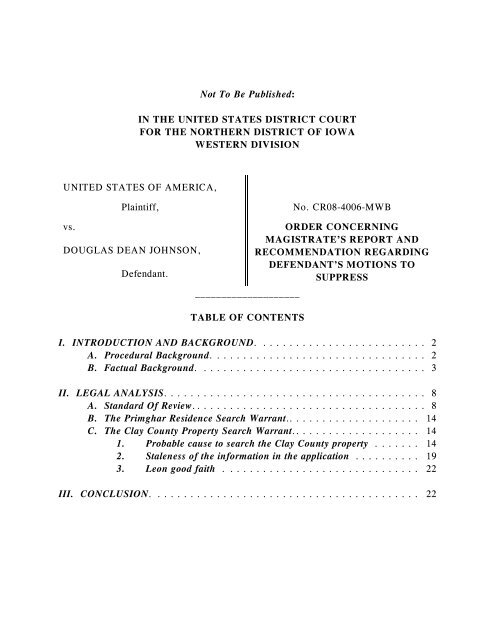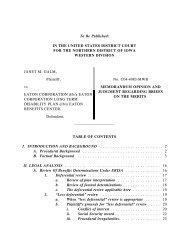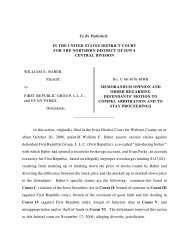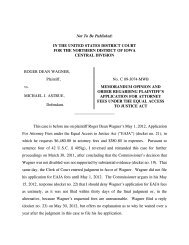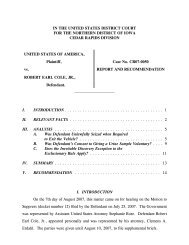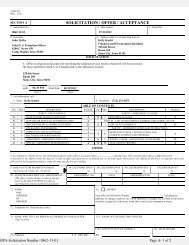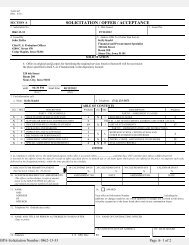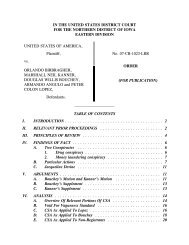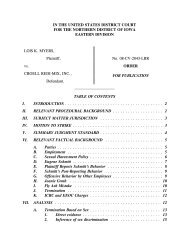Not To Be Published - Northern District of Iowa
Not To Be Published - Northern District of Iowa
Not To Be Published - Northern District of Iowa
You also want an ePaper? Increase the reach of your titles
YUMPU automatically turns print PDFs into web optimized ePapers that Google loves.
<strong>Not</strong> <strong>To</strong> <strong>Be</strong> <strong>Published</strong>:<br />
IN THE UNITED STATES DISTRICT COURT<br />
FOR THE NORTHERN DISTRICT OF IOWA<br />
WESTERN DIVISION<br />
UNITED STATES OF AMERICA,<br />
Plaintiff,<br />
No. CR08-4006-MWB<br />
vs.<br />
DOUGLAS DEAN JOHNSON,<br />
Defendant.<br />
____________________<br />
TABLE OF CONTENTS<br />
ORDER CONCERNING<br />
MAGISTRATE’S REPORT AND<br />
RECOMMENDATION REGARDING<br />
DEFENDANT’S MOTIONS TO<br />
SUPPRESS<br />
I. INTRODUCTION AND BACKGROUND. ......................... 2<br />
A. Procedural Background. ................................ 2<br />
B. Factual Background. .................................. 3<br />
II. LEGAL ANALYSIS. ....................................... 8<br />
A. Standard Of Review.................................... 8<br />
B. The Primghar Residence Search Warrant..................... 1 4<br />
C. The Clay County Property Search Warrant.................... 1 4<br />
1. Probable cause to search the Clay County property ....... 1 4<br />
2. Staleness <strong>of</strong> the information in the application .......... 1 9<br />
3. Leon good faith . ............................. 2 2<br />
III. CONCLUSION. ........................................ 2 2
I. INTRODUCTION AND BACKGROUND<br />
A. Procedural Background<br />
On January 24, 2008, an indictment was returned against defendant Douglas Dean<br />
Johnson charging him with conspiracy to manufacture and distribute 50 grams or more <strong>of</strong><br />
pure methamphetamine, to distribute pseudoephedrine knowing that it would be used in the<br />
manufacture <strong>of</strong> methamphetamine and to possess pseudoephedrine, after having previously<br />
being convicted <strong>of</strong> a felony drug <strong>of</strong>fense, in violation <strong>of</strong> 21 U.S.C. §§ 841(a)(1),<br />
841(b)(1)(A), 841(c)(1), 841(c)(2), 846, and 851, and interstate travel in aid <strong>of</strong><br />
racketeering, in violation <strong>of</strong> 18 U.S.C. § 1952(a)(3). Defendant Johnson has filed two<br />
motions to suppress (Dkt. #70 & #71). In one motion to suppress, defendant Johnson<br />
seeks to suppress evidence seized from a Primghar, <strong>Iowa</strong>, residence during the execution<br />
<strong>of</strong> a search warrant issued on May 8, 2007, while in the other he seeks to suppress<br />
evidence seized during a search <strong>of</strong> his property, outbuildings, and curtilage in Clay<br />
County, <strong>Iowa</strong>, during the execution <strong>of</strong> a search warrant issued on July 11, 2007.<br />
Defendant Johnson’s motion to suppress was referred to Chief United States<br />
Magistrate Judge Paul A. Zoss, pursuant to 28 U.S.C. § 636(b). Judge Zoss conducted<br />
a hearing on defendant Johnson’s motions and then filed a Report and Recommendation<br />
in which he concluded that the search warrant application for the Primghar residence failed<br />
to support the state magistrate’s probable cause determination. Moreover, Judge Zoss<br />
found that the search warrant application was so facially deficient that the state magistrate’s<br />
issuance <strong>of</strong> a search warrant constituted “a rubber stamp for the police.” Judge Zoss,<br />
thus, concluded that the exclusionary rule should be applied and the evidence seized during<br />
the execution <strong>of</strong> the search warrant for the Primghar residence should be excluded. With<br />
respect to the search warrant for the Clay County property, Judge Zoss found that the<br />
2
totality <strong>of</strong> the information presented to the state magistrate supported the state magistrate’s<br />
probable cause determination. Judge Zoss further found that the information contained in<br />
the search warrant application was not stale. Finally. Judge Zoss concluded that it was not<br />
objectively unreasonable for the law enforcement <strong>of</strong>ficers here to proceed to execute the<br />
search warrant for the Clay County property in these circumstances. Therefore, Judge<br />
Zoss recommended defendant Johnson’s motion to suppress the evidence seized in the<br />
search <strong>of</strong> the Primghar residence be granted while defendant Johnson’s motion to suppress<br />
the evidence seized in the search <strong>of</strong> the Clay County property be denied. Defendant<br />
Johnson has filed objections to Judge Zoss’s Report and Recommendation, but only with<br />
respect to his motion to suppress evidence seized during a search <strong>of</strong> his property in Clay<br />
County, <strong>Iowa</strong>. Neither party has filed objections concerning defendant Johnson’s motion<br />
to suppress evidence seized from the Primghar residence. The court, therefore, undertakes<br />
the necessary review <strong>of</strong> Judge Zoss’s recommended disposition <strong>of</strong> defendant Johnson’s<br />
motions to suppress.<br />
B. Factual Background<br />
In his Report and Recommendation, Judge Zoss made the following findings <strong>of</strong> fact:<br />
On May 8, 2007, Lt. Randall Kramer, an O’Brien<br />
County Sheriff’s Deputy, prepared an Application for Search<br />
Warrant to search the following person and property:<br />
Douglas Dean Johnson<br />
375 3rd Street N.W. Primghar, O’Brien County,<br />
<strong>Iowa</strong>; Described as brown 1 1/2 story single<br />
family dwelling with an attached 2 stall garage<br />
(see attached O’Brien County Assessor’s sheet<br />
and photos)<br />
3
1991 Chev blue/silver pickup bearing <strong>Iowa</strong><br />
license [number]<br />
1984 Chev Cavalier brown-bearing <strong>Iowa</strong> license [number]<br />
2000 Ford Taurus blue-bearing <strong>Iowa</strong> license [number]<br />
Doc. No. 71-3 at 5. Lt. Kramer stated the above person and<br />
property contained “certain property, namely:<br />
Pseudoephedrine pills, lithium batteries, ether, sulfuric acid,<br />
muriatic acid, plastic tubing, glass ware, c<strong>of</strong>fee filters,<br />
packaging materials, blender, aluminum foil,<br />
methamphetamines, drug paraphernalia, ledgers, scales,<br />
monies, [and] drug notes,” all <strong>of</strong> which he indicated was<br />
“[p]roperty that has been obtained in violation <strong>of</strong> law”;<br />
“[p]roperty, the possession <strong>of</strong> which is illegal”; “[p]roperty<br />
used or possessed with intent to be used as the means <strong>of</strong><br />
committing a public <strong>of</strong>fense or concealed to prevent an <strong>of</strong>fense<br />
from being discovered”; and “[p]roperty relevant and material<br />
as evidence in a criminal prosecution.” Id. at 5-6.<br />
In support <strong>of</strong> the search warrant application, Lt. Kramer<br />
submitted an Affidavit in which he stated, “Doug Johnson has<br />
made the following purchases <strong>of</strong> products containing<br />
pseudoephedrine on the dates listed,” listing nine transactions<br />
between April 11 and April 26, 2007, at several pharmacies in<br />
Minnesota, and one pharmacy in <strong>Iowa</strong>. Id. at 10. He stated<br />
the nine pseudoephedrine purchases by “Doug Johnson in a 30<br />
day period” totaled “20.4 grams <strong>of</strong> pseudoephedrine.” Id. He<br />
cited “<strong>Iowa</strong> Code § 126.23A(2)a,” which he stated prohibits<br />
a person from purchasing more than 7500 milligrams, or 7.5<br />
grams, <strong>of</strong> pseudoephedrine in any 30-day period. He further<br />
stated the following:<br />
Based on this investigator[’]s training and<br />
experience it is known that persons that are<br />
involved with manufacturing methamphetamine<br />
will travel to several stores to obtain the<br />
pseudoephedrine pills, lithium batteries and other<br />
4
items that are needed to manufacture the<br />
methamphetamines. It is also known by this<br />
investigator based on his training and experience<br />
that persons involved in the gathering <strong>of</strong> the<br />
materials used in the manufacturing <strong>of</strong><br />
methamphetamines, will store (hide) these items<br />
at their residence and/or in their vehicles. That<br />
persons involved with the gathering and/or<br />
manufacturing <strong>of</strong> methamphetamines will also be<br />
involved in the sale and/or use <strong>of</strong> illegal drugs<br />
and that they will store (hide) items such as<br />
pipes, scales, ledgers, illegal drugs, monies, and<br />
other drug paraphernalia at their residence<br />
and/or in their vehicles.<br />
Id.<br />
Lt. Kramer attached a printout from the O’Brien County<br />
Assessor’s Office showing that the real property located at 375<br />
3rd Street, N.W. in Primghar, <strong>Iowa</strong>, was owned by a Denise<br />
D. Moore f/k/a Denise D. Philiph, and listing certain<br />
information about the residence on the property (dimensions,<br />
number <strong>of</strong> bedrooms and bathrooms, finish, plumbing,<br />
appliances, etc.). He also attached an unlabeled photograph <strong>of</strong><br />
a house, presumably the house in question. Id. at 7-9.<br />
No other information was provided in support <strong>of</strong> the<br />
search warrant application. The magistrate who reviewed the<br />
application indicated he had “relied on [the] written<br />
Application for Search Warrant <strong>of</strong> Randall Kramer,<br />
Attachment A [the Affidavit] and attached Asses[s]or record<br />
and photo.” Id. at 11. Under “Abstract <strong>of</strong> Testimony,” the<br />
magistrate wrote “None,” indicating no further information<br />
was received beyond that set forth in the application. Id.<br />
In the application for the search warrant and the<br />
supporting documents, Lt. Kramer made no connection<br />
5
whatsoever between Johnson and the property to be searched,<br />
nor did he inform the court how he determined that the<br />
defendant Douglas Dean Johnson was the same “Doug<br />
Johnson” who purchased the pseudoephedrine. The <strong>of</strong>ficer<br />
provided no information to indicate Johnson’s connection to<br />
the residence sought to be searched; his relationship, if any, to<br />
or with the property owner Ms. Moore; who owned the<br />
vehicles listed in the warrant application and what their<br />
connection was to the residence or to Johnson; or what<br />
information led the <strong>of</strong>ficer to believe evidence <strong>of</strong> criminal<br />
activity might be found at the residence, in the vehicles, or on<br />
Johnson’s person. Regarding the list <strong>of</strong> pseudoephedrine<br />
purchases, the <strong>of</strong>ficer stated he had “conducted an<br />
investigation and received information from fellow <strong>of</strong>ficers and<br />
other sources” indicating “Doug Johnson” had made the listed<br />
pseudoephedrine purchases. See Doc. No. 71-3 at 10. He<br />
failed to cite the source <strong>of</strong> his information sufficiently for the<br />
court to determine if the source was reliable.<br />
. . .<br />
On July 11, 2007, Clay County Sheriff’s Deputy Casey<br />
Timmer prepared an Application for Search Warrant to search<br />
“a Morton-type building on the property <strong>of</strong> Doug Johnson<br />
located at 2970 290th Street, Dickens, Clay County, <strong>Iowa</strong>,<br />
other outbuildings on the property, [and] the curtilage <strong>of</strong> said<br />
property,” for “pseudoephedrine, methamphetamine, ledger<br />
books, books <strong>of</strong> account, scales, seal a meal machines, baggies<br />
or other packaging materials, paraphernalia used for the<br />
consumption and packaging <strong>of</strong> drugs or to contain the same,<br />
money, and remnants <strong>of</strong> methamphetamine lab[.]” Doc.<br />
No. 70-3 at 2. In support <strong>of</strong> the warrant application, Deputy<br />
Timmer prepared an affidavit in which he detailed<br />
pseudoephedrine purchases by “Doug Johnson” between<br />
June 18 and 26, 2007, totaling 10,320 mg., in excess <strong>of</strong> the<br />
legal limit <strong>of</strong> 7500 mg. in a thirty-day period under <strong>Iowa</strong> law.<br />
See id. at 3-4.<br />
6
In his affidavit, Deputy Timmer also provided the<br />
following information:<br />
The [pharmacy] logs show a Primghar<br />
address for Johnson. The undersigned is aware<br />
that Johnson also owns a property located at<br />
2970 290th Street, Dickens, Clay County, <strong>Iowa</strong>.<br />
On this date [i.e. July 11, 2007], the<br />
undersigned went to that property with O’Brien<br />
County Lt. Randy Kramer. While at the<br />
residence, the undersigned spoke with the<br />
tenants <strong>of</strong> the property, Randy and Kim <strong>Be</strong>rger.<br />
Tenants advised that they do not have access to<br />
a certain Morton-type building on the property,<br />
but that Johnson does frequent that building at<br />
least weekly. The undersigned could see that the<br />
windows <strong>of</strong> the building are covered with a<br />
combination <strong>of</strong> wood, cardboard, and styr<strong>of</strong>oam.<br />
Tenants also showed the undersigned a burn<br />
barrel on the premises. In plain view toward the<br />
top <strong>of</strong> the pile in the burn barrel were a number<br />
<strong>of</strong> ripped lithium batteries, consistent with<br />
having been used in the methamphetamine<br />
manufacturing process, along with what appears<br />
to be empty pseudoephedrine blister packs.<br />
There are a number <strong>of</strong> other outbuildings on the<br />
premises where illegal items could be stored.<br />
Based on training and experience, I know<br />
that persons manufacturing methamphetamine<br />
can and do use other people to purchase<br />
pseudoephedrine for them. Pseudoephedrine is<br />
a key ingredient in the manufacture <strong>of</strong><br />
methamphetamine. People buying<br />
pseudoephedrine for methamphetamine<br />
manufacturers <strong>of</strong>ten receive methamphetamine in<br />
exchange for these purchases. These persons<br />
7
also will shop different stores on the same date<br />
in an attempt to avoid detection by law<br />
enforcement. As users <strong>of</strong> methamphetamine,<br />
they <strong>of</strong>ten maintain drugs, paraphernalia, notes,<br />
and cash for the purchases <strong>of</strong> pseudoephedrine in<br />
their homes or other buildings. They also use<br />
their vehicles for transportation to make the<br />
purchases and to store the contraband.<br />
Johnson shopped for pseudoephedrine in<br />
different stores on the same date. He also<br />
violated <strong>Iowa</strong> Code § 124.213 by purchasing<br />
more than 7500 mg pseudoephedrine in a 30 day<br />
period. These are indications that the<br />
pseudoephedrine was purchased for use in the<br />
manufacture <strong>of</strong> methamphetamine.<br />
A review <strong>of</strong> Johnson’s criminal history<br />
shows drug related convictions.<br />
Doc. No. 70-3 at 4-5.<br />
In the magistrate’s Endorsement on the search warrant<br />
application, she indicated she relied on Deputy Timer’s<br />
affidavit and also on sworn testimony taken from the deputy.<br />
As the abstract <strong>of</strong> the <strong>of</strong>ficer’s testimony, the magistrate<br />
incorporated the deputy’s Affidavit. Doc. No. 70-3 at 6. The<br />
magistrate found the information presented justified probable<br />
cause, and she issued the search warrant. Id.<br />
Report and Recommendation at 7-9, 11-12.<br />
Upon review <strong>of</strong> the record, the court adopts all <strong>of</strong> Judge Zoss’s factual findings that<br />
have not been objected to by defendant Johnson.<br />
II. LEGAL ANALYSIS<br />
A. Standard Of Review<br />
8
The court reviews the magistrate judge’s report and recommendation pursuant to<br />
the statutory standards found in 28 U.S.C. § 636(b)(1):<br />
A judge <strong>of</strong> the court shall make a de novo determination <strong>of</strong><br />
those portions <strong>of</strong> the report or specified proposed findings or<br />
recommendations to which objection is made. A judge <strong>of</strong> the<br />
court may accept, reject, or modify, in whole or in part, the<br />
findings or recommendations made by the magistrate judge.<br />
The judge may also receive further evidence or recommit the<br />
matter to the magistrate judge with instructions.<br />
28 U.S.C. § 636(b)(1) (2006); see Fed. R. Civ. P. 72(b) (stating identical requirements);<br />
N.D. IA. L.R. 72, 72.1 (allowing the referral <strong>of</strong> dispositive matters to a magistrate judge<br />
but not articulating any standards to review the magistrate judge’s report and<br />
recommendation). While examining these statutory standards, the United States Supreme<br />
Court explained:<br />
Any party that desires plenary consideration by the Article III<br />
judge <strong>of</strong> any issue need only ask. Moreover, while the statute<br />
does not require the judge to review an issue de novo if no<br />
objections are filed, it does not preclude further review by the<br />
district judge, sua sponte or at the request <strong>of</strong> a party, under a<br />
de novo or any other standard.<br />
Thomas v. Arn, 474 U.S. 140, 154 (1985). Thus, a district court may review de novo any<br />
issue in a magistrate judge’s report and recommendation at any time. Id. If a party files<br />
an objection to the magistrate judge’s report and recommendation, however, the district<br />
court must “make a de novo determination <strong>of</strong> those portions <strong>of</strong> the report or specified<br />
proposed findings or recommendations to which objection is made.” 28 U.S.C.<br />
§ 636(b)(1). In the absence <strong>of</strong> an objection, the district court is not required “to give any<br />
more consideration to the magistrate’s report than the court considers appropriate.”<br />
Thomas, 474 U.S. at 150.<br />
9
De novo review, <strong>of</strong> course, is nondeferential and generally allows a reviewing court<br />
to make an “independent review” <strong>of</strong> the entire matter. Salve Regina College v. Russell,<br />
499 U.S. 225, 238 (1991) (noting also that “[w]hen de novo review is compelled, no form<br />
<strong>of</strong> appellate deference is acceptable”); see Doe v. Chao, 540 U.S. 614, 620-19 (2004)<br />
(noting de novo review is “distinct from any form <strong>of</strong> deferential review”). The de novo<br />
review <strong>of</strong> a magistrate judge’s report and recommendation, however, only means a district<br />
court “‘give[s] fresh consideration to those issues to which specific objection has been<br />
made.’” United States v. Raddatz, 447 U.S. 667, 675 (1980) (quoting H.R. Rep. No. 94-<br />
1609, at 3, reprinted in 1976 U.S.C.C.A.N. 6162, 6163 (discussing how certain<br />
amendments affect 28 U.S.C. § 636(b))). Thus, while de novo review generally entails<br />
review <strong>of</strong> an entire matter, in the context <strong>of</strong> § 636 a district court’s required de novo<br />
review is limited to “de novo determination[s]” <strong>of</strong> only “those portions” or “specified<br />
proposed findings” to which objections have been made. 28 U.S.C. § 636(b)(1); see<br />
Thomas, 474 U.S. at 154 (“Any party that desires plenary consideration by the Article III<br />
judge <strong>of</strong> any issue need only ask.” (emphasis added)). Consequently, the Eighth Circuit<br />
Court <strong>of</strong> Appeals has indicated de novo review would only be required if objections were<br />
“specific enough to trigger de novo review.” Branch v. Martin, 886 F.2d 1043, 1046 (8th<br />
Cir. 1989). Despite this “specificity” requirement to trigger de novo review, the Eighth<br />
Circuit Court <strong>of</strong> Appeals has “emphasized the necessity . . . <strong>of</strong> retention by the district<br />
court <strong>of</strong> substantial control over the ultimate disposition <strong>of</strong> matters referred to a<br />
magistrate.” <strong>Be</strong>lk v. Purkett, 15 F.3d 803, 815 (8th Cir. 1994). As a result, the Eighth<br />
Circuit has been willing to “liberally construe[]” otherwise general pro se objections to<br />
require a de novo review <strong>of</strong> all “alleged errors,” see Hudson v. Gammon, 46 F.3d 785,<br />
786 (8th Cir. 1995), and to conclude that general objections require “full de novo review”<br />
if the record is concise, <strong>Be</strong>lk, 15 F.3d at 815 (“Therefore, even had petitioner’s objections<br />
10
lacked specificity, a de novo review would still have been appropriate given such a concise<br />
record.”). Even if the reviewing court must construe objections liberally to require de<br />
novo review, it is clear to this court that there is a distinction between making an objection<br />
and making no objection at all. See Coop. Fin. Assoc., Inc. v. Garst, 917 F. Supp. 1356,<br />
1373 (N.D. <strong>Iowa</strong> 1996) (“The court finds that the distinction between a flawed effort to<br />
bring objections to the district court’s attention and no effort to make such objections is<br />
appropriate.”). Therefore, this court will strive to provide de novo review <strong>of</strong> all issues<br />
that might be addressed by any objection, whether general or specific, but will not feel<br />
compelled to give de novo review to matters to which no objection at all has been made.<br />
In the absence <strong>of</strong> any objection, the Eighth Circuit Court <strong>of</strong> Appeals has indicated<br />
a district court should review a magistrate judge’s report and recommendation under a<br />
clearly erroneous standard <strong>of</strong> review. See Grinder v. Gammon, 73 F.3d 793, 795 (8th Cir.<br />
1996) (noting when no objections are filed and the time for filing objections has expired,<br />
“[the district court judge] would only have to review the findings <strong>of</strong> the magistrate judge<br />
for clear error”); Taylor v. Farrier, 910 F.2d 518, 520 (8th Cir. 1990) (noting the<br />
advisory committee’s note to Fed. R. Civ. P. 72(b) indicates “when no timely objection<br />
is filed the court need only satisfy itself that there is no clear error on the face <strong>of</strong> the<br />
record”); Branch, 886 F.2d at 1046 (contrasting de novo review with “clearly erroneous<br />
standard” <strong>of</strong> review, and recognizing de novo review was required because objections<br />
were filed). The court is unaware <strong>of</strong> any case that has described the clearly erroneous<br />
standard <strong>of</strong> review in the context <strong>of</strong> a district court’s review <strong>of</strong> a magistrate judge’s report<br />
and recommendation to which no objection has been filed. In other contexts, however, the<br />
Supreme Court has stated the “foremost” principle under this standard <strong>of</strong> review “is that<br />
‘[a] finding is “clearly erroneous” when although there is evidence to support it, the<br />
reviewing court on the entire evidence is left with the definite and firm conviction that a<br />
11
mistake has been committed.’” Anderson v. City <strong>of</strong> <strong>Be</strong>ssemer City, 470 U.S. 564, 573-74<br />
(1985) (quoting United States v. U.S. Gypsum Co., 333 U.S. 364, 395 (1948)). Thus, the<br />
clearly erroneous standard <strong>of</strong> review is deferential, see Dixon v. Crete Medical Clinic,<br />
P.C., 498 F.3D 837, 847 (8th Cir. 2007) (noting a finding is not clearly erroneous even<br />
if another view is supported by the evidence), but a district court may still reject the<br />
magistrate judge’s report and recommendation when the district court is “left with a<br />
definite and firm conviction that a mistake has been committed,” U.S. Gypsum Co., 333<br />
U.S. at 395.<br />
Even though some “lesser review” than de novo is not “positively require[d]” by<br />
statute, Thomas, 474 U.S. at 150, Eighth Circuit precedent leads this court to believe that<br />
a clearly erroneous standard <strong>of</strong> review should generally be used as the baseline standard<br />
to review all findings in a magistrate judge’s report and recommendation that are not<br />
objected to or when the parties fail to file any timely objections, see Grinder, 73 F.3d at<br />
795; Taylor, 910 F.2d at 520; Branch, 886 F.2d at 1046; see also Fed. R. Civ. P. 72(b)<br />
advisory committee’s note (“When no timely objection is filed, the court need only satisfy<br />
itself that there is no clear error on the face <strong>of</strong> the record in order to accept the<br />
recommendation.”). In the context <strong>of</strong> the review <strong>of</strong> a magistrate judge’s report and<br />
recommendation, the court believes one further caveat is necessary: a district court always<br />
remains free to render its own decision under de novo review, regardless <strong>of</strong> whether it<br />
feels a mistake has been committed. See Thomas, 474 U.S. at 153-54. Thus, while a<br />
clearly erroneous standard <strong>of</strong> review is deferential and the minimum standard appropriate<br />
12
in this context, it is not mandatory, and the district court may choose to apply a less<br />
deferential standard. 1<br />
1<br />
The Eighth Circuit Court <strong>of</strong> Appeals, in the context <strong>of</strong> a dispositive matter<br />
originally referred to a magistrate judge, does not review a district court’s decision in<br />
similar fashion. The Eighth Circuit Court <strong>of</strong> Appeals will either apply a clearly erroneous<br />
or plain error standard to review factual findings, depending on whether the appellant<br />
originally objected to the magistrate judge’s report and recommendation. See United States<br />
v. Brooks, 285 F.3d 1102, 1105 (8th Cir. 2002) (“Ordinarily, we review a district court’s<br />
factual findings for clear error . . . . Here, however, the record reflects that [the<br />
appellant] did not object to the magistrate’s report and recommendation, and therefore we<br />
review the court’s factual determinations for plain error.” (citations omitted)); United<br />
States v. Looking, 156 F.3d 803, 809 (8th Cir. 1998) (“[W]here the defendant fails to file<br />
timely objections to the magistrate judge’s report and recommendation, the factual<br />
conclusions underlying that defendant’s appeal are reviewed for plain error.”). The plain<br />
error standard <strong>of</strong> review is different than a clearly erroneous standard <strong>of</strong> review, see<br />
United States v. Barth, 424 F.3d 752, 764 (8th Cir. 2005) (explaining the four elements<br />
<strong>of</strong> plain error review), and ultimately the plain error standard appears to be discretionary,<br />
as the failure to file objections technically waives the appellant’s right to appeal factual<br />
findings, see Griffini v. Mitchell, 31 F.3d 690, 692 (8th Cir. 1994) (stating an appellant<br />
who did not object to the magistrate judge’s report and recommendation waives his or her<br />
right to appeal factual findings, but then choosing to “review[] the magistrate judge’s<br />
findings <strong>of</strong> fact for plain error”). An appellant does not waive his or her right to appeal<br />
questions <strong>of</strong> law or mixed questions <strong>of</strong> law and fact by failing to object to the magistrate<br />
judge’s report and recommendation. United States v. <strong>Be</strong>nshop, 138 F.3d 1229, 1234 (8th<br />
Cir. 1998) (“The rule in this circuit is that a failure to object to a magistrate judge’s report<br />
and recommendation will not result in a waiver <strong>of</strong> the right to appeal ‘“when the questions<br />
involved are questions <strong>of</strong> law or mixed questions <strong>of</strong> law and fact.”’” (quoting Francis v.<br />
Bowen, 804 F.2d 103, 104 (8th Cir. 1986), in turn quoting Nash v. Black, 781 F.2d 665,<br />
667 (8th Cir. 1986))). In addition, legal conclusions will be reviewed de novo, regardless<br />
<strong>of</strong> whether an appellant objected to a magistrate judge’s report and recommendation. See,<br />
e.g., United States v. Maxwell, 498 F.3d 799, 801 n.2 (8th Cir. 2007) (“In cases like this<br />
one, ‘where the defendant fails to file timely objections to the magistrate judge’s report and<br />
recommendation, the factual conclusions underlying that defendant’s appeal are reviewed<br />
for plain error.’ We review the district court’s legal conclusions de novo.” (citation<br />
(continued...)<br />
13
As noted above, defendant Johnson has filed an objection to Judge Zoss’s Report<br />
and Recommendation. The court, therefore, undertakes the necessary review <strong>of</strong> Judge<br />
Zoss’s recommended disposition <strong>of</strong> defendant Johnson’s motions to suppress.<br />
B. The Primghar Residence Search Warrant<br />
No party has filed an objection to Judge Zoss’s Report and Recommendation as it<br />
pertains to defendant Johnson’s motion to suppress evidence seized from the Primghar<br />
residence, and it appears to the court upon review <strong>of</strong> Judge Zoss’s findings and conclusions<br />
as to that part <strong>of</strong> Judge Zoss’s Report and Recommendation, that there is no ground to<br />
reject or modify them. Therefore, the court accepts that part <strong>of</strong> Judge Zoss’s Report and<br />
Recommendation with respect to defendant Johnson’s motion to suppress evidence seized<br />
from the Primghar residence, and orders that defendant Johnson’s motion to suppress (Dkt.<br />
#70) is granted.<br />
C. The Clay County Property Search Warrant<br />
As noted above, defendant Johnson has filed objections to that portion <strong>of</strong> Judge<br />
Zoss’s Report and Recommendation concerning defendant Johnson’s motion to suppress<br />
evidence seized during a search <strong>of</strong> his property, outbuildings, and curtilage in Clay<br />
County. The court will take up each <strong>of</strong> defendant Johnson’s objections to Judge Zoss’s<br />
Report and Recommendation seriatim.<br />
1. Probable cause to search the Clay County property<br />
Defendant Johnson initially objects to Judge Zoss’s conclusion that the totality <strong>of</strong><br />
the information presented to the state magistrate supported the state magistrate’s probable<br />
1<br />
(...continued)<br />
omitted)).<br />
14
cause determination. Defendant Johnson contends that the search warrant application for<br />
the Clay County property was constitutionally deficient because there was insufficient<br />
information to indicate that there was a fair probability that contraband or evidence <strong>of</strong> a<br />
crime would be found in the places identified in the search warrant application.<br />
The seminal case <strong>of</strong> Illinois v. Gates, 462 U.S. 213 (1983), provides the standard<br />
an issuing court must follow in determining whether probable cause supports a search<br />
warrant application and, consequently, the duty <strong>of</strong> the reviewing court when considering<br />
the propriety <strong>of</strong> that determination:<br />
Id. at 238.<br />
The task <strong>of</strong> the issuing magistrate is simply to make a<br />
practical, common-sense decision whether, given all the<br />
circumstances set forth in the affidavit before him, including<br />
the "veracity" and "basis <strong>of</strong> knowledge" <strong>of</strong> persons supplying<br />
hearsay information, there is a fair probability that contraband<br />
or evidence <strong>of</strong> a crime will be found in a particular place.<br />
The question presented on review <strong>of</strong> an issuing judicial <strong>of</strong>ficer's determination is<br />
not whether the reviewing court would have issued the warrant based on the affidavit as<br />
presented, but whether the court which did issue the warrant had a "'substantial basis for<br />
. . . conclud[ing]' that probable cause existed." Id. at 238-239 (citation omitted). Thus,<br />
a reviewing court does not conduct a de novo review <strong>of</strong> the issuing judge's determination,<br />
but must instead afford it great deference. Id. at 236. As the United States Supreme Court<br />
explained in Gates:<br />
[W]e have repeatedly said that after-the-fact scrutiny by courts<br />
<strong>of</strong> the sufficiency <strong>of</strong> an affidavit should not take the form <strong>of</strong> de<br />
novo review. A magistrate's "determination <strong>of</strong> probable<br />
cause should be paid great deference by reviewing courts."<br />
[Spinelli v. United States, 393 U.S. 410, 419, 89 S. Ct. 584,<br />
590, 21 L.Ed. 2d 637 (1969) ]. "A grudging or negative<br />
15
attitude toward warrants," [United States v. Ventresca, 380<br />
U.S. 102, 108, 85 S. Ct. 741, 745-46, 13 L.Ed. 2d 684<br />
(1965)], is inconsistent with the Fourth Amendment's strong<br />
preference for searches conducted pursuant to a warrant;<br />
"courts should not invalidate warrant[s] by interpreting<br />
affidavit[s] in a hypertechnical, rather than a commonsense,<br />
manner." Id., at 109, 85 S. Ct. at 746.<br />
Gates, 462 U.S. at 236; see United States v. Hansel, ---F.3d---, 2008 WL 1913886, at *2<br />
(8th Cir. May 2, 2008) (“Whether probable cause to issue a search warrant has been<br />
established is determined by considering the totality <strong>of</strong> the circumstances, and resolution<br />
<strong>of</strong> the question by an issuing judge ‘should be paid great deference by reviewing courts.’”)<br />
(quoting United States v. Grant, 490 F.3d 627, 631 (8th Cir. 2007)).<br />
The Eighth Circuit Court <strong>of</strong> Appeals has weighed in on this topic as well, most<br />
recently observing that:<br />
Probable cause to search exists if, under the totality <strong>of</strong> the<br />
circumstances, “‘there is a fair probability that contraband or<br />
evidence <strong>of</strong> a crime will be found in a particular place.’”<br />
Hansel, ---F.3d---, 2008 WL 1913886, at *2 (quoting United States v. Caswell, 436 F.3d<br />
894, 897 (8th Cir. 2006) (quoting in turn Gates, 462 U.S. at 238)); see also United States<br />
v. Summage, 481 F.3d 1075, 1077 (8th Cir. 2007) (“Probable cause exists, if under the<br />
totality <strong>of</strong> the circumstances, a showing <strong>of</strong> facts can be made ‘sufficient to create a fair<br />
probability that evidence <strong>of</strong> a crime will be found in the place to be searched.’” ) (quoting<br />
United States v. Underwood, 364 F.3d 956, 963 (8th Cir. 2004) (quoting in turn United<br />
States v. Gabrio, 295 F.3d 880, 883 (8th Cir. 2002)); United States v. Wells, 223 F.3d<br />
835, 838 (8th Cir. 2000) (“The evidence as a whole must provide a substantial basis for<br />
a finding <strong>of</strong> probable cause to support the issuance <strong>of</strong> a search warrant.”); United States<br />
v. Johnson, 219 F.3d 790, 790 (8th Cir. 2000) ("Probable cause means a fair probability<br />
16
that contraband or evidence <strong>of</strong> a crime will be found in a particular place given the<br />
circumstances set forth in the affidavit.") (quoting United States v. Tellez, 217 F.3d 547<br />
(8th Cir. 2000) (in turn quoting United States v. Horn, 187 F.3d 781 (8th Cir. 1999)<br />
(internal quotation marks omitted)); United States v. Gladney, 48 F.3d 309, 312 (8th Cir.<br />
1995) (“Probable cause exists when "there are sufficient facts to justify the belief by a<br />
prudent person that contraband or evidence <strong>of</strong> a crime will be found in the place to be<br />
searched.” )(quoting United States v. Bieri, 21 F.3d 811, 815 (8th Cir.1994)). Equally<br />
on point is the observation <strong>of</strong> Justice (then Judge) Kennedy:<br />
For probable cause to exist, a magistrate need not determine<br />
that the evidence sought is in fact on the premises to be<br />
searched, or that the evidence is more likely than not to be<br />
found where the search takes place. The magistrate need only<br />
conclude that it would be reasonable to seek the evidence in the<br />
place indicated in the affidavit.<br />
United States v. Peacock, 761 F.2d 1313, 1315 (9th Cir. 1985), cert. denied, 474 U.S. 847<br />
(1985) (emphasis added in part) (citations omitted). Where, as here, the issuing state<br />
magistrate relied solely on the affidavit presented to her, “‘only that information which is<br />
found within the four corners <strong>of</strong> the affidavit may be considered in determining the<br />
existence <strong>of</strong> probable cause.’” Gladney, 48 F.3d at 312 (quoting United States v.<br />
Leichtling, 684 F.2d 553, 555 (8th Cir. 1982), cert. denied, 459 U.S. 1201 (1983)).<br />
Upon review <strong>of</strong> the record and Judge Zoss’s Report and Recommendation, the court<br />
concludes that Judge Zoss correctly concluded that there was a substantial basis to support<br />
the state magistrate’s finding <strong>of</strong> probable cause to search defendant Johnson’s property in<br />
Clay County. The court recognizes that the Eighth Circuit Court <strong>of</strong> Appeals has held that<br />
"punctilious paragraph-by-paragraph dissection <strong>of</strong> the supporting affidavit" is not the<br />
appropriate standard <strong>of</strong> review. United States v. <strong>To</strong>wnsley, 843 F.2d 1070, 1076 (8th Cir.<br />
17
1988); see United States v. Leisure, 844 F.3d 1347, 1354 (8th Cir. 1988) (declining to<br />
“undertake a piecemeal dismemberment <strong>of</strong> the various paragraphs <strong>of</strong> the affidavit without<br />
attention to its force as a whole.”). Rather, the court acknowledges that a determination<br />
<strong>of</strong> probable cause depends on a reading <strong>of</strong> the affidavit as a whole. Gates, 462 U.S. at 237.<br />
Here, viewing the affidavit in a common sense manner, the court cannot say that the issuing<br />
state magistrate did not have a substantial basis to believe that the items sought in the<br />
warrant would be found at defendant Johnson’s Clay County property. Specifically, the<br />
search warrant application contained information detailing the fact that defendant Johnson<br />
had made five purchases <strong>of</strong> pseudoephedrine between June 18, 2007 and June 26, 2007, in<br />
which defendant Johnson purchased 10,320 milligrams <strong>of</strong> pseudoephedrine. This level <strong>of</strong><br />
pseudoephedrine purchases exceeded the 7,500 milligrams limit on pseudoephedrine<br />
defendant Johnson could purchase in a 30 day period under <strong>Iowa</strong> law. See IOWA CODE<br />
§ 126.213A. On July 11, 2007, the date the search warrant was issued, Inv. Timmer and<br />
Lt. Kramer <strong>of</strong> the O’Brien County Sheriff’s Office went to defendant Johnson’s Clay<br />
County property at 2970 290th Street in Dickens, <strong>Iowa</strong>. Inv. Timmer spoke with the<br />
tenants <strong>of</strong> the property, Randy and Kim <strong>Be</strong>rger, who advised that while they did not have<br />
access to a certain Morton-type building on the property, defendant Johnson did have access<br />
to it and frequented that building at least weekly. Furthermore, while the windows <strong>of</strong> the<br />
building were covered, the tenants <strong>of</strong> the property showed Inv. Timmer a burn barrel on<br />
the premises, where in plain view, on top <strong>of</strong> the pile in the burn barrel, were a number <strong>of</strong><br />
ripped lithium batteries and empty pseudoephedrine blister packs. These items, the ripped<br />
lithium batteries and empty pseudoephedrine blister packs, were consistent with having been<br />
used in the methamphetamine manufacturing process. The search warrant application<br />
further contained information, drawn from Inv. Timmer’s training and experience, that<br />
pseudoephedrine is a key ingredient in the manufacture <strong>of</strong> methamphetamine and that the<br />
18
purchases <strong>of</strong> pseudoephedrine in violation <strong>of</strong> <strong>Iowa</strong> law suggested that the pseudoephedrine<br />
was purchased for use in the manufacture <strong>of</strong> methamphetamine. Finally, the search warrant<br />
application contained information that defendant Johnson had a criminal history which<br />
included drug related convictions. The court concludes that when all <strong>of</strong> this information<br />
is considered in the totality, and giving “great deference” to the resolution reached by the<br />
state magistrate, see Hansel, ---F.3d---, 2008 WL 1913886, at *2; Grant, 490 F.3d at 631;<br />
Caswell, 436 F.3d at 897, the information contained within the search warrant application<br />
provides sufficient information to support the state magistrate’s probable cause<br />
determination here. Therefore, this objection is overruled.<br />
2. Staleness <strong>of</strong> the information in the application<br />
Defendant Johnson also objects to Judge Zoss’s conclusion that the information<br />
contained in the search warrant application was not stale. Defendant Johnson contends that<br />
the information provided by Inv. Timmer was stale and that, as a result, probable cause did<br />
not exist at the time the search warrant was issued.<br />
“It is axiomatic that probable cause must exist at the time <strong>of</strong> the search and not<br />
merely at sometime earlier.” United States v. Kennedy, 427 F.3d 1136, 1141 (8th Cir.<br />
2005); see United States v. Formaro, 152 F.3d 768, 771 (8th Cir. 1998); United States v.<br />
Ozar, 50 F.3d 1440, 1446 (8th Cir. 1995). Therefore, a lapse <strong>of</strong> time, between the<br />
observations <strong>of</strong> a witness and the issuance <strong>of</strong> a search warrant “may make probable cause<br />
fatally stale.” United States v. Maxim, 55 F.3d 394, 397 (8th Cir.), cert. denied, 516 U.S.<br />
903 (1995). However, the Eighth Circuit Court <strong>of</strong> Appeals has instructed that: “‘We have<br />
no ‘fixed formula’ for deciding when information has become stale, but we consider the<br />
nature <strong>of</strong> the crime being investigated and the property to be searched.’” United States v.<br />
Nieman, ---F.3d---, 2008 WL 860781, at *3 (8th Cir. Apr. 2, 2008) (quoting United States<br />
v. Stevens, 439 F.3d 983, 988 (8th Cir. 2006) (citation omitted)); see Maxim, 55 F.3d at<br />
19
397. Thus, the passage <strong>of</strong> time alone is “not always the controlling factor,” since other<br />
factors, such as “the nature <strong>of</strong> the criminal activity involved and the kind <strong>of</strong> property<br />
subject to the search,” may also be relevant to the staleness calculus. Maxim, 55 F.3d at<br />
397 (citing United States v. Koelling, 992 F.2d 817, 822 (8th Cir. 1993)).<br />
Moreover,“‘where recent information corroborates otherwise stale information, probable<br />
cause may be found.’” Ozar, 50 F.3d at 1446 (quoting United States v. Macklin, 902 F.2d<br />
1320, 1326 (8th Cir. 1990), cert. denied, 498 U.S. 1031 (1991)). “The passage <strong>of</strong> time<br />
between the transactions on which a warrant is based and the ensuing search is less<br />
significant when the facts recited indicate activity <strong>of</strong> a continuous nature.” United States v.<br />
Jones, 801 F.2d 304, 314 (8th Cir.1986); see also United States v. Rugh, 968 F.2d 750 (8th<br />
Cir. 1992). As the Second Circuit Court <strong>of</strong> Appeals has noted that: “‘[N]arcotics<br />
conspiracies are the very paradigm <strong>of</strong> the continuing enterprises for which the courts have<br />
relaxed the temporal requirements <strong>of</strong> non-staleness.’” United States v. Rowell, 903 F.2d<br />
899, 903 (2d Cir. 1990). The Eighth Circuit Court <strong>of</strong> Appeals has similarly observed that:<br />
“‘In investigations <strong>of</strong> ongoing narcotic operations, “intervals <strong>of</strong> weeks or months between<br />
the last described act and the application for a warrant [does] not necessarily make the<br />
information stale.’”” United States v. Smith, 266 F.3d 902, 905 (8th Cir. 2001) (quoting<br />
Formaro, 152 F.3d at 771); United States v. Pitts, 6 F.3d 1366, 1369 (9th Cir. 1993)<br />
(“‘With respect to drug trafficking, probable cause may continue for several weeks, if not<br />
months, <strong>of</strong> the last reported instance <strong>of</strong> suspect activity.’”) (quoting United States v.<br />
Angulo-Lopez, 791 F.2d 1394, 1399 (9th Cir. 1986)).<br />
In this case, the search warrant application reflects an investigation <strong>of</strong> activities<br />
consistent with drug trafficking. Inv. Trimmer’s review <strong>of</strong> pseudoephedrine logs <strong>of</strong> local<br />
pharmacies had unearthed a series <strong>of</strong> purchases <strong>of</strong> products containing pseudoephedrine,<br />
a key ingredient in the manufacture <strong>of</strong> pseudoephedrine, by defendant Johnson, all <strong>of</strong> which<br />
20
transpired no later than three weeks before the date the search warrant was issued. All told,<br />
defendant Johnson purchased 10,320 milligrams <strong>of</strong> pseudoephedrine in a period <strong>of</strong> less than<br />
ten days. Defendant Johnson’s purchases <strong>of</strong> products containing pseudoephedrine were not<br />
only suspicious because <strong>of</strong> the quantity purchased, but also because he made purchases from<br />
different stores on the same date. On June 26, 2007, the pseudoephedrine logs at Spirit<br />
Lake Lewis Drug, Spirit Lake Wal-Mart and Milford Pharmacy reflected that defendant<br />
Johnson had purchased products containing pseudoephedrine from each totaling 5520<br />
milligrams <strong>of</strong> pseudoephedrine. The search warrant application was further supported by<br />
Inv. Timmer’s observation, in plain view in a burn barrel at defendant Johnson’s Clay<br />
County property, <strong>of</strong> “a number or ripped lithium batteries, consistent with having been used<br />
in the methamphetamine manufacturing process, along with what appears to be empty<br />
pseudoephedrine blister packs.” These observations occurred on the same day the search<br />
warrant was issued. Finally, defendant Johnson’s tenants for his Clay County property told<br />
Inv. Timmer that defendant Johnson frequented a building on the property “at least<br />
weekly.”<br />
In this case, given that methamphetamine manufacturing activity was suspected, the<br />
two and one-half weeks lapse since defendant Johnson’s last known purchase <strong>of</strong><br />
pseudoephedrine did not negate the existence <strong>of</strong> probable cause given that on the date the<br />
search warrant was sought law enforcement <strong>of</strong>ficers had observed in plain view, at the<br />
location <strong>of</strong> the proposed search, the remnants <strong>of</strong> materials used in the manufacture <strong>of</strong><br />
methamphetamine. Moreover, law enforcement <strong>of</strong>ficers ascertained that defendant Johnson<br />
frequented a building on the property “at least weekly.” Therefore, considering the totality<br />
<strong>of</strong> the information provided to the state magistrate, the court concludes the search warrant<br />
for defendant Johnson’s Clay County property was not based on stale information. See<br />
Smith, 266 F.3d at 905; Formaro, 152 F.3d at 771; see also United States v. Hartje, 251<br />
21
F.3d 771, 775 (8th Cir. 2001)(concluding that a drug transaction one month prior to the<br />
search warrant application did not constitute stale information in light <strong>of</strong> the ongoing nature<br />
<strong>of</strong> the crime). Therefore, this objection is also overruled.<br />
3. Leon good faith<br />
Finally, defendant Johnson objects to Judge Zoss’s alternative conclusion that even<br />
if the search warrant for defendant Johnson’s Clay County property was not supported by<br />
probable cause, the search is lawful under the good faith exception <strong>of</strong> United States v.<br />
Leon, 468 U.S. 897 (1984). In Leon, the United States Supreme Court held that evidence<br />
obtained pursuant to a subsequently invalidated search warrant need not be excluded from<br />
the prosecution's case in chief if the executing <strong>of</strong>ficers acted in objectively reasonable<br />
reliance on the issuing court's determination <strong>of</strong> probable cause and technical sufficiency.<br />
Id. at 922-23. “[A]bsent allegations that the [issuing judge] was not neutral, ‘suppression<br />
is appropriate only if the <strong>of</strong>ficers were dishonest or reckless in preparing their affidavit or<br />
could not have harbored an objectively reasonable belief in the existence <strong>of</strong> probable<br />
cause.’” United States v. Fulgham, 143 F.3d 399, 401 (8th Cir. 1998) (quoting Leon, 468<br />
U.S. at 926). Here, no evidence exists in the record to suggest that the state magistrate<br />
did not remain neutral and detached when making her probable cause determination.<br />
Moreover, no evidence has been <strong>of</strong>fered which would suggest that the state magistrate<br />
“wholly abandoned [her] judicial role.” See Leon, 468 U.S. at 923 (stating that suppression<br />
remains an appropriate remedy when the issuing judge wholly abandons his judicial role).<br />
Therefore, the court also overrules defendant Johnson’s objection as to Judge Zoss’s Leon<br />
analysis.<br />
22
III. CONCLUSION<br />
Therefore, for the reasons set forth above, the court, upon a de novo review <strong>of</strong> the<br />
record, accepts Judge Zoss’s Report and Recommendation and grants defendant Johnson’s<br />
motion to suppress the evidence seized in the search <strong>of</strong> the Primghar residence (Dkt. #71)<br />
but denies defendant Johnson’s motion to suppress the evidence seized in the search <strong>of</strong> the<br />
Clay County property (Dkt. #70).<br />
IT IS SO ORDERED.<br />
DATED this 14th day <strong>of</strong> May, 2008.<br />
__________________________________<br />
MARK W. BENNETT<br />
U. S. DISTRICT COURT JUDGE<br />
NORTHERN DISTRICT OF IOWA<br />
23


